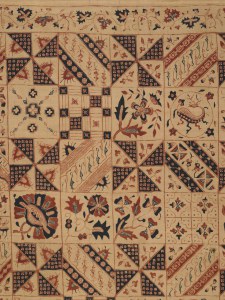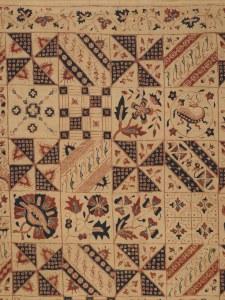With Five Centuries of Indonesian Textiles set to close on September 6, I made a point to revisit the galleries to take in the craft behind these beautiful objects—especially the batiks.

Woman’s Skirt Cloth (Kain panjang), Java, probably Cirelon, late nineteenth century, cotton plain weave with hand-drawn wax resist dyeing (batik tulis), Mary Hunt Kahlenberg Collection
The process of making batiks is an extensive one, practiced for hundreds of years using a wax-resist dye method. After preparing the fabric with inked designs, wax is applied with a special canting tool, then dyed in one color. Wax is then applied to other areas of the fabric and immersed into a different color dye. This process is repeated until the desired effect is achieved. Once all the colors have been applied, the excess wax is removed. Here’s a clip that illustrates the process:
Motifs typically designed on batiks are specific to nature—flora or fauna. While the tradition of batik-making is endemic to Indonesia, the influence of these textiles is widespread. This is evident in the LACMA installation; some batiks clearly depict characteristics from Indian, Chinese, and Arabic cultures. Batiks can also be seen in contemporary art, though in this case not quite in its traditional form. Yinka Shonibare MBE, whose first solo exhibition on the West Coast was at the Santa Barbara Museum of Art this past spring, uses batiks as a clever means to express his critique on the effect of European imperialism and colonization. Using batiks popular in Africa which were appropriated by way of the Indo-Dutch trade, Shonibare creates costumes in typical seventeenth and eighteenth–century European fashion. Shonibare cheekily merges the aspects of culture of one country with that of another country once under its rule. (For those of you in New York, his work is currently on display at the Brooklyn Museum of Art.) If you’ve been fortunate to see Shonibare’s works earlier this month or plan to see them on the East Coast, be sure to check out the batiks in their original form here at LACMA. The beauty of a batik in its traditional fashion is just as incredible as seeing it as an artistic medium veiled by an artist’s sly censure. Devi Noor



